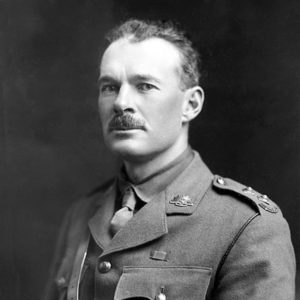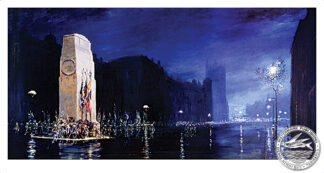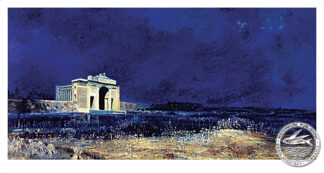LONGSTAFF, William

“LONGSTAFF, William Frederick (1879-1953), artist, was born on 25th December 1879 at Ballarat, Victoria, son of Thomas Longstaff, pharmacist, and his wife Frederica Elizabeth, née Francis, both English born. He was a cousin of (Sir) John Longstaff. Will was educated at Grenville College, Ballarat, studied art at the Ballarat School of Mines, and had experience as a jackaroo. In 1900-01 he spent sixteen months as a trooper in charge of remounts with the South African Light Horse during the South African War. He later went to Europe where he continued his art studies, attending the Heatherley School of Fine Art in London in 1908. On his return to Victoria he taught art privately and in 1910-11 with Leslie Wilkie. Longstaff and his wife Eliza Mary lived at Eltham.
In October 1915 he joined the Australian Imperial Force, embarking as captain for Egypt in November with the 1st Australian Remount Unit. Longstaff was invalided to England in October 1917 and next year was selected for camouflage training and attached to the 2nd Division Headquarters as divisional artist under the Australian Records Section war art scheme. While in Egypt he had made pictorial records of the Anzac Mounted Division and the Desert Column. In June 1918 he was billeted with Arthur Streeton and on occasion they worked side by side painting such scenes as Amiens Cathedral and the salvage dump at Glisy. Longstaff, a skilful and innovative camouflage worker, took plane flights to note effects from the air. His thoroughness contributed to successful concealment of allied activity before the offensive of 8 August and probably saved many lives.
After the war Longstaff joined the group of artists who worked for the Australian War Records Section at its St John’s Wood studio, London, preparing material for display in the proposed Australian War Memorial; these included paintings depicting the battle of 8 August 1918 and the breaking of the Hindenburg line (25 September). He subsequently moved to Sussex, where he lived quietly with his second wife and two children while maintaining a London studio. In 1919 he was represented in the Royal Academy of Arts annual exhibition by a watercolour ‘Somme Valley’. He painted many unambitious views of the Sussex landscape, exhibiting with the Society of Australian Artists, London, in 1920. He also undertook many portrait commissions including those of David Lloyd George and Sir Granville Ryrie.
Will Longstaff is best known for his large, popular, allegorical paintings of ghostly fallen soldiers on battlefields, such as ‘Menin Gate at Midnight’ (‘Ghosts of Menin Gate’) 1927, and the ‘Immortal Shrine’ (‘Eternal Silence’). The former was purchased by Lord Woolavington for 2000 guineas and presented to the Australian government (Australian War Memorial) in 1928. When this painting was exhibited in 1928-29 it created a sensation and reproductions were sold in great numbers. The painting met the need of many at the time to remember those who had died and the contemporary interest in spiritualism. ‘Carillon’, a third allegorical picture, painted in 1934, depicting New Zealand war dead haunting the Belgian coast, is in the National Art Gallery, Wellington; and a fourth painting, of Vimy Ridge, with the spirits of the Canadian Corps, was presented to the Canadian government.Longstaff died on 1 July 1953 at Littlehampton, Sussex.”
Anne Gray, ‘Longstaff, William Frederick (Will) (1879-1953)’, Australian Dictionary of Biography, Volume 10, Melbourne University Press, 1986, pp 142-143.
Showing all 2 results
-

IMMORTAL SHRINE – William Longstaff – Giclee Print – 46 x 75 cm
$ 100.00 Add to cart -

MENIN GATE AT MIDNIGHT – William Longstaff – Giclee Print – 75 x 46cm
$ 100.00 Add to cart
Showing all 2 results
